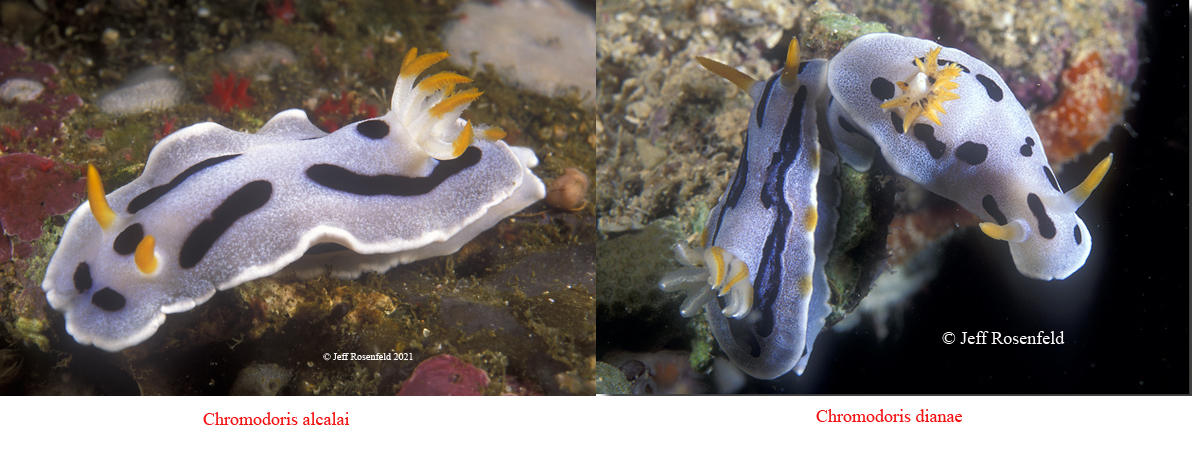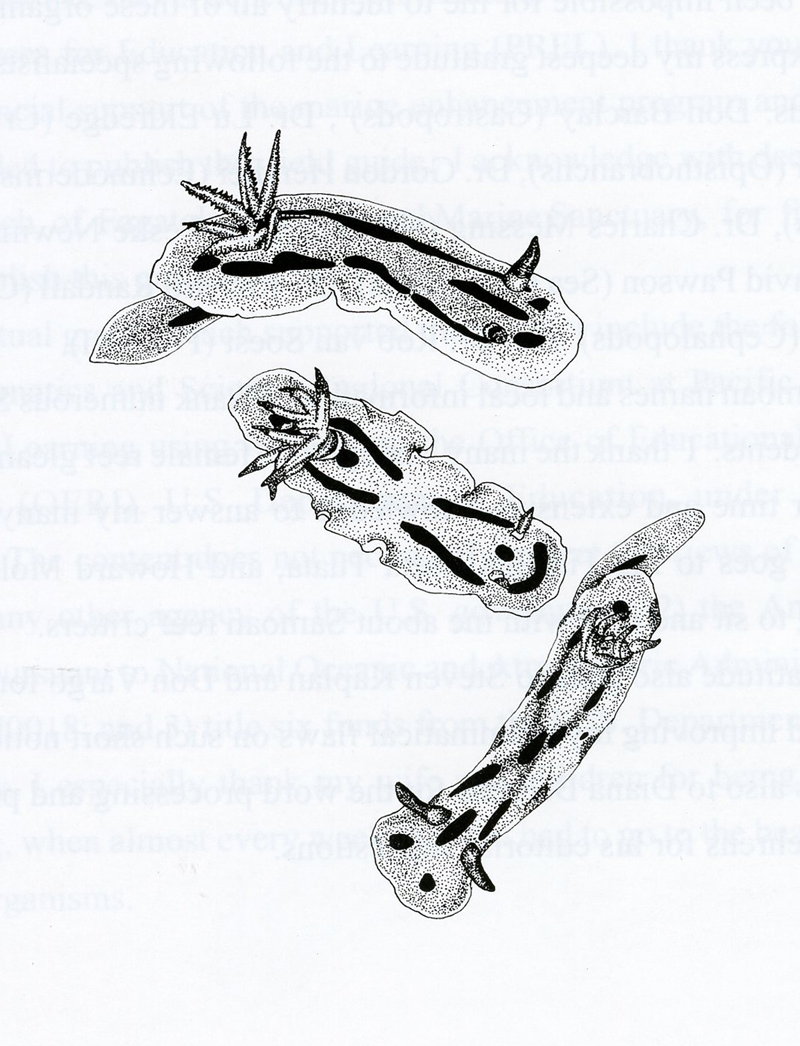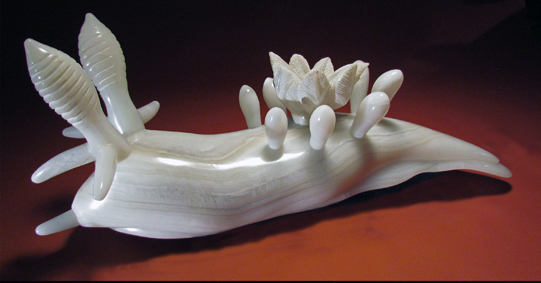 |
Anilao, Batangas, Philippines
Webmaster's Notes: Jeff is the webmaster of Vibrantsea.net , a must visit for all you sluggers!
|
Line Drawing from the original description of Chromodoris dianae Top two specimens are now Chromodoris alcalai, bottom specimen is C. dianae Image courtesy of Dave Behrens  |
The Chromodoris dianae conundrum Well how about this crazy slug story? It is even one I was involved with. The story is told by Dr. Terry Gosliner, in his latest paper - Sleuthing cryptic Chromodorids (Mollusca, Nudibranchia): adding to Philippine marine biodiversity. Let me see if I can lay out the details chronologically and clearly. In 1998, Terry and I described five species of Chromodoris from the Philippines. One of them was given the trivial name dianae after my ex-wife. Don't ask me why. In the description we showed a range of color patterns, some being white to pale blue with a black curved line across the anterior end of the animal followed by two black lines or curved bands extending posteriorly on the outer side of the body, that may be variously angled and have no orange spots, while others are white or pale blue with black spots rather than an arch on the head. The lateral black lines can be continuous or discontinuous. Orange marginal spots may be either present or absent around the mantle margin and the white margin is less obvious and more diffuse. Recent molecular studies by Layton et al. (2018) revealed that the two distinct color variations are in fact distinct. There were other key character differences overlooked by Terry and I such as gill color patterns and arrangement. So here is where things get messy. Genetic analysis of the holotype described in the original paper revealed that it matched Chromodoris sp. 7 in Nudibranch & Sea Slug Identification, not the group with coloration we have all called C. dianae. So, what does this mean? - it means C. dianae needed a new name and C. sp. 7 was now C. dianae. Terry chose to name the now defunct C. dianae - Chromodoris alcalai to honor Professor Angel Alcala's on his 90th birthday and his pioneering contributions to preserve the marine biodiversity of the Philippines. We hope the photos included here will help you distinguish between the two species in the future. This is the perfect example of how science in constantly improving and advancing our knowledge of the subtle relationships between species. Reference:
Gosliner, T.M. & Behrens, D.W. 1998. Five new species of Chromodoris (Mollusca: Nudibranchia: Chromodorididae) from the tropical Indo-West Pacific. Proceedings of the California Academy of Sciences, 50: 139-165. Dave Behrens Sammamish, WA 98074 Aug., 2021 Send Dave email at davidwbehrens@gmail.com |
Ancula gibbosa by Gar Waterman
 |
For all you sluggers that live on the East coast, there is an opportunity to visit an exhibt dear to our hearts at the Maritime Museum in Norwalk, Connecticut! The exhibit was featured in an article in the most recent issue of Alert Diver , but if you're not a member of DAN, here are the details. "...In addition to live nudibranchs and other mollusks, this exhibit features nudibranchs depicted in onyx and marble sculptures by Gar Waterman of New Haven, as well as nudibranch photographs by underwater photographers from all around the world including Gordon Tillen, Keith Ellenbogen, Kevin Lee, Alicia Hermosilla, Emanuel Goncalves and Jim Anderson..." The exhibit runs through Labor day so don't delay! |

Attention all you Sluggers, and you know who you are! The NSSI 2nd edition is now available in ebook PDF and book form . The hard back version will become available Nov. 1st. Both will cost $65 (individually). You will need to jump through a few hoops to get the electronic version as pdf distribution is protected by Adobe ID!! Please read the following to enable reading your electronic purchase! This new 2nd Edition is updated and reorganized, including 185 new species. Among other features, the new edition includes additional photographs of species, an identification key, and an up-to-date classification reflecting the latest evolutionary relationships. The Indo-Pacific represents the largest expanse of tropical ocean in the world, stretching from the Indian Ocean coast of southern Africa and the Red Sea to the central Pacific of the Hawaiian Islands, Easter Island and the Marquesas. This region supports the most diverse marine fauna of any place in the world for most groups of marine organisms. The nudibranchs and sea slugs are no exception to this rule; there are about 3,000 described species of these organisms in the world and at least 40% of these have been found exclusively in the Indo-Pacific tropics. This book illustrates 2,138 Indo-Pacific nudibranchs and sea slugs, including many undescribed species.
|

|
